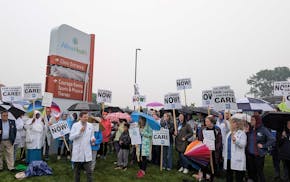Minneapolis-based Fairview's recent string of operating losses didn't stop its chief executive from receiving nearly $1.4 million in annual bonus and incentive pay in 2022.
The pay matches a national trend of nonprofits opting to provide incentive compensation even when financial performance fell short of targets, consultants say.
In November, Fairview Health Services pointed to its series of financial losses over a four-year period to illustrate why it can't maintain current payment levels for academic medicine at the University of Minnesota.
According to a Star Tribune review, data for the most recent of those years, 2022, show Fairview's pay increase fits with compensation jumps for the CEOs at three other large Minnesota health systems, none of which paid performance-based incentives during the previous year.
Consultants say nonprofits generally are concerned about retaining their top executives.
"Minnesota hospitals and health systems are facing unprecedented financial challenges that are testing the skills and resilience of even the most experienced leaders," the Minnesota Hospital Association said in a statement. "Compensation is one way hospital boards — which represent their larger communities — are trying to keep good leaders in place, working 24x7 on this crisis."
The Star Tribune's annual report on executive compensation and financial performance at the state's largest nonprofit groups examined pay data across 10 health systems and health insurers in 2022.
With more incentive pay in the mix, median compensation for the CEOs was $2.46 million, an increase of 25% compared with the previous year. Pay changes for individual executives ranged from -2% to 67%.
Median pay in 2022, which includes compensation for executives new to the job, was nearly back to 2020 levels after a decline in 2021.
For the first time, three CEOs saw total compensation of more than $3 million, according to data in November filings with the IRS.
Pay data for 2022 was not yet available from two of the state's largest nonprofits — St. Cloud-based CentraCare and Duluth-based Essentia Health.
Incentive pay in down years
Like other nonprofits, Fairview says its approach to compensation is based on a rigorous process, citing the use of external consultants and industry benchmarks that compare peer health systems.
There was no incentive pay for Fairview CEO James Hereford after operating losses in 2019 and 2020. When the health system in 2021 again lost money on operations, the board of directors used discretion to award incentive pay for Hereford, other top executives and more than 1,000 of its roughly 34,000 employees.
This compensation, which shows in 2022 pay figures, was based on above-target performance on patient experience measures, as well as quality and safety scores, Fairview said.
"The board agreed that to retain staff who persevered through two very hard years, we needed to adjust," the health system said in a statement. "Navigating health care's tremendous financial pressures and specifically, retaining leaders with deep academic health experience, requires stable and highly capable executive leadership."
Fairview owns University of Minnesota Medical Center and jointly operates with the U a network of hospitals and clinics called M Health Fairview.
In an October 2022 letter, two University of Minnesota leaders who serve on Fairview's board, said it was alarming that Hereford, as a "highly-compensated CEO," had not articulated a turnaround strategy for the health system. Fairview says Hereford has been working on a plan that delivered improved financial performance last year and highest-ever marks on quality, safety and patient experience.
Hospitals and clinics suffered extreme disruption with the COVID-19 pandemic, and subsequent labor and supply costs meant many health systems across the country fell short of financial targets, said Toni Dolby, a managing director with Gallagher, a human resources consultant.
In their compensation plans, nonprofits often have a "trigger" for incentive pay only when targets for financial performance are met, she said. But many boards of directors also have discretion to suspend these triggers and provide at least some incentive compensation.
"A lot of organizations [and] boards used that discretion to say: 'Look, financials are so out of our control right now and we really want to be able to pay our team members. We didn't hit our financial goal, so we might not be paying on that, but we'll pay on the people and quality measures as the plan dictated based on performance,'" said Dolby, who did not comment on pay at Fairview in particular.
Chief executive Gianrico Farrugia of the Mayo Clinic had the largest compensation total at $3.72 million, up 7%. Mayo doesn't provide incentive pay to its CEOs, saying the "philosophy is in line with our salaried approach (no bonuses)" for physicians plus executives and employees responsible for clinical practice, research and education.
"The CEO's salary (similar to other Mayo executives' salaries) is set below the market average when they start their role and catches up during their time in the role," the health system said.
Hereford at Fairview ranked second among Minnesota's nonprofit CEOs with total pay increasing 18% to about $3.28 million, which included a retention bonus.
CEOs at Children's Minnesota, HealthPartners and Hennepin Healthcare received incentive compensation in 2022 when there were no such payments the previous year. That helped push overall pay for Andrea Walsh, the HealthPartners CEO, up 64% to nearly $3.1 million.
"Overall, our incentive plan encourages and rewards leaders for achieving results," HealthPartners said in a statement.
In 2022, John Naylor, the former CEO at Medica, earned the most bonus/incentive pay on the Star Tribune list at $1.5 million. The health insurer did not respond to questions about the pay package.
No profit, no bonus?
Nonprofit filings lump together bonuses and incentive pay, even though consultants say they're distinct. A bonus might be awarded for retention, they say, whereas overall pay packages assume a salary plus an incentive payment that varies with performance.
Across the country, health systems have drawn different conclusions on whether financial triggers with incentive pay should be suspended given the industry's challenges, consultants said. These financial triggers were kept in place, and therefore blocked payouts, last spring at Robbinsdale-based North Memorial and this year at Hennepin Healthcare in Minneapolis.
In some cases, consultants say boards have recoiled at the optics of paying incentives if workers aren't getting raises, or financial results are weak enough to upset bondholders.
But Alexander Yaffe, managing director with Pearl Meyer, a compensation consulting firm, said he thinks boards have been right to provide incentives. These boards are saying, "we need to make money; we don't want to pay compensation out of red ink. But we don't exist to make money as a tax-exempt health care organization. If we have improved access and we have improved quality ... [that] should be recognized."
Non-financial measures should be part of the conversation when setting CEO pay, said Dr. Vikas Saini, president of the Lown Institute, a Massachusetts-based group that evaluates executive compensation, but there's virtually no public information on exactly how nonprofits grade their CEO's performance on things such as quality, safety and patient experience.
"We need a lot more transparency," Saini said. "I think that would make everyone feel more comfortable since there are a lot of public dollars at stake."

Bushel Boy, Minnesota's local tomato grower, sold
After 60 years, federal cuts shutting down Job Corps center in St. Paul

In a first, Minnesota doctors walk their own picket line, then hustle to see patients
It's harder to find a job this year, especially a corporate position

